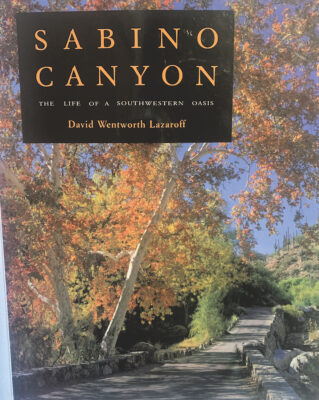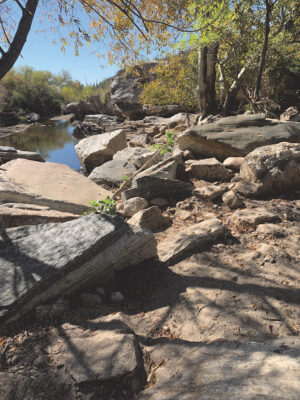Mountain and desert: Sabino Canyon in Tucson has both
 I had forgotten about the charms of Tucson. In winter, where one can swim outside in a heated pool beneath brilliant sun, a weekend in Tucson seems like a good idea.
I had forgotten about the charms of Tucson. In winter, where one can swim outside in a heated pool beneath brilliant sun, a weekend in Tucson seems like a good idea.
The Santa Catalina Mountains, to the north and northeast of Tucson, rise up over the Sonoran Desert, and are crowned by the 9,000-foot Mt. Lemmon. My heart sings when I think of one of the mountain canyons there, cut by the rain-and-snow-fed Sabino Creek, which tumbles down from Mt. Lemmon to feed the riparian habitat in the canyon 6,000 feet below.
On a recent hike in Lower Sabino Canyon, at the creek by a small dam, I noticed some unusually beautiful two-toned granite underfoot. (I recognized granite! No matter how much I read about geology, almost nothing sticks.)

BOOK on the Southwestern Oasis was published in 1991.
This was the first time in 30 years I had been in that canyon.
Back then, I was hiking with two young girls: my daughter and her friend Natalie. It was March 17, 1991, and in the magical bright blue sky close to midday was the full moon. The Santa Catalina Mountains were of course above us, and I recall thinking of complete happiness — the gifts of the beloved girls, the moon, Sabino Creek full of rushing water. Spring. So much life!
But the water in the creek in early November coming over the modest 1939 Lower Sabino Canyon Dam (built by the Federal Emergency Relief Administration) was like the tap in my bathtub. I learned from David Wentworth Lazaroff’s excellent 1991 book, “Sabino Canyon: The Life of a Southwestern Oasis,” that it was still the “after-summer” season. Still hot, still dry. “Day by day, the stream recedes, then breaks into a chain of still ponds mirroring the dry desert slopes,” writes Lazaroff.
Forest recreation
Sabino Canyon Recreational Area is part of the Coronado National Forest, administered by the Catalina Ranger District. For the young and intrepid, there is a trail ascending about 5,000 feet, close to the top of Mt. Lemmon, which is, by the way, the southernmost ski area in the U.S. But there are a number of easy and moderate trails. The diversity of plant and animal life here is stunning. The mountain slopes at lower elevations are Sonoran Desert scrub, the paloverde-saguaro community variety. Along the creek is riparian woodland and mesquite bosque — and three more biotic communities.
But of course any wild area designated for “recreation” is in danger of being loved to death. We were there on a crowded weekend.

SABINO DAM in Tucson’s Sabino Canyon, begun by the Emergency Relief Administration in 1937.
This beautiful canyon was almost lost to a number of major dam schemes over the decades of the 20th century, threatening the fate of Sabino Canyon — think of the loss of the Hetch-Hetchy Valley in Yosemite. But somehow, luck (in the form of lack of funds) was with Sabino Canyon. It endures.
That flowing color and texture of the two-toned granite? It’s a hard metamorphic rock called the “Catalina gneiss.” The dark bands are remnants of ancient granite; the light bands are younger rocks that have extruded into the older. It’s like the swirl of steamed milk in your latte. Sort of.
Joseph Wood Krutch (1893-1970), ecologist, naturalist, cultural critic and Columbia professor, took a 15-month sabbatical on the desert near the Santa Catalina Mountains in the late ’40s. For months, he did not leave his property, absorbing all of himself into the desert. His memoir of his time there, “The Desert Year,” was published in 1951. He took to the desert, and moved there permanently in 1953.

BEFORE WINTER, Sabino Creek dries up into small pools — and will be replenished by rain and snowmelt.
“Not to have known — as most men have not — either the mountain or the desert is not to have known one’s self,” Krutch writes.
Mountain and desert are both on offer here in Sabino Canyon.
Category: Real Estate
